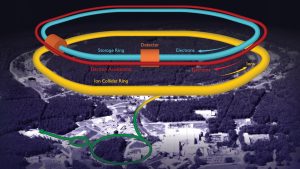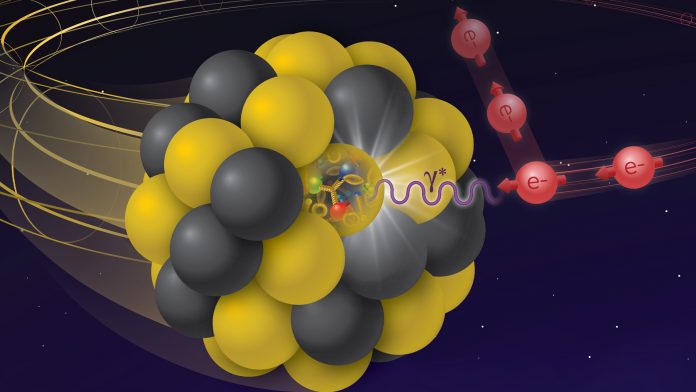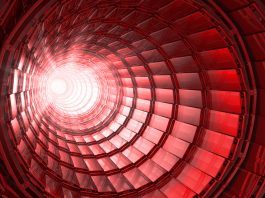Physicist Dr Daria Sokhan discusses how the UK will be at the forefront of development for the EIC particle accelerator in the US.
Physicists from around the world are collaborating on the build of a new particle collider set to address many of the yet unanswered questions surrounding the nature of matter. The powerful particle accelerator, the Electron-Ion Collider (EIC), will be built at Brookhaven National Laboratory in the US and will be the world’s first collider of polarised electrons with polarised protons or polarised light ions. It will also be the world’s first collider of polarised electrons with heavy nuclei.
UK scientists will make a fundamental contribution to the development of the facility. Funded by £3m from the Science and Technology Facilities Council (STFC), nuclear and particle physicists from across the UK are set to lead the design of several important detector sub-systems for the accelerator.
The University of Glasgow is just one of the UK contributors to the project, responsible for developing smaller detector arrays for particle tracking in challenging regions of very high intensity. To find out more about the University’s role in the project and what it is hoped that the EIC will achieve, Innovation News Network spoke to Dr Daria Sokhan, Senior Lecturer from the School of Physics and Astronomy at the University of Glasgow and currently Blaise Pascal Chair at CEA Saclay in France.
Firstly, can you explain more about the particle accelerator and Electron-Ion Collider project and the University of Glasgow’s role?
The Electron-Ion Collider (EIC) is the next premier facility for hadron physics in the world. It will be the world’s first to collide polarised electron beams with polarised beams of protons and light ions, as well as a full range of unpolarised heavy ions right up the mass ladder to uranium. This capability, as well as the extreme intensity of the particle accelerator colliding beams, make it a phenomenal precision microscope for studying the structure of the nucleus and of the protons and neutrons within it. The collision energies envisaged will bring into focus the richly gluon-saturated region of the proton. Gluons are the force-carriers of the strong interaction – the fundamental force which binds quarks into protons and neutrons and holds nuclei together. It is at the basis of almost all of the visible mass of the universe and the marvellous complexity of matter from which we, our planet, and the stars are made.
A critical part of the EIC are the detectors, which will provide the ‘eyepiece’ of the microscope. What the EIC will be able to do is only as good as the detectors with which it will be instrumented. The EIC community around the world is now dedicating its effort and experience to the design of the complex detector systems to be able to detect, measure, and characterise as many of the particles produced in the particle accelerator collisions as possible. In every second, there will be millions of collisions at the interaction points, with each collision resulting in a particular process taking place according to the laws of physics and probability.
A good detector should be able to record as much as possible from what flies out of these collisions – the scattered electrons and protons or ions from the beams, and the new particles produced in these processes – with enough precision to be able to reconstruct which particle belonged to which collision. On this basis, physicists can then determine exactly what happened in the interactions, and study the forces at play.
Making the most of the EIC’s capability will require pushing detector technologies to the very edge – and this is something that multiple groups around the world are currently working on, including the Nuclear and Hadron Physics group at the University of Glasgow. Glasgow is one of the founding members of the Medipix collaboration, which developed extremely high-resolution pixel sensors for use in medical applications. Out of this grew Timepix, which combined the high position-resolution with timing information.
The Glasgow group is working on R&D to develop Timepix-based detectors to track charged particles which are scattered at the smallest angles from the beam. This opens up the possibility to fully reconstruct a whole class of processes where either the electron or the proton were barely deflected from their original trajectories. These processes hold the key, amongst other things, to imaging, for the first time, the gluon distributions of the proton in 3D.
What can you achieve by being involved from such an early stage?
It takes years to design and build a facility of this size and complexity, and the designs of much of the detector systems are being finalised now – ten years before the first beams are scheduled to collide. In fact, the EIC community is currently working on different proposals for the detector design and one of these will be chosen early next year, to instrument the first interaction region. While it seems early because of the long timescales, it is in fact the perfect time to get involved if we want to make an impact on the design of the collider and its detectors – and, therefore, the physics which it will be able to do.
The international EIC community has spent 2020 producing the EIC Yellow Report – a hefty 800-page volume defining the physics which the EIC will be able to study and its detector requirements. The UK had significant leadership in this endeavour. Now, a series of UK groups are leading aspects of the detector design and R&D, with funding from STFC and UK Research and Innovation (UKRI). It is exciting to be involved at this crucial stage because we are creating the future of hadron physics and particle accelerator research. It, of course, also places us in an ideal position to lead aspects of the EIC physics programme, once the EIC begins to operate.
How will you collaborate with other UK laboratories on the project?
We already do. The UK has a number of groups working on complementary aspects of the EIC detector R&D. While Glasgow is focussed on novel detectors for charged particles very close to the beamline, a consortium of other UK groups, led by Birmingham, are developing innovative trackers for charged particles for the central part of the detector, based on silicon MAPS technology.
The group in York is focussing on the development of a completely new method of polarimetry – the ability to read the polarisation (orientation of spin) of the particles produced in the collisions. These are all different parts of the complex detector array, and other aspects of it are being designed and will be constructed by other groups in the international community. The UKRI funding, which has been received by the UK groups to enable UK contribution, is a single grant, co-led by Birmingham and Glasgow, with different groups being responsible for different work packages within it. All the UK groups are also working within the bigger detector collaborations – currently both ATHENA and ECCE, which are developing two proposals for the EIC detector design.
The nature of this challenging project is very collaborative, and this helps to bring out the best and the most innovative solutions. The UK also works closely with the groups in France, notably CEA Saclay who are working on complementary tracking technology using MicroMegas and on the design of the large magnet within which the central detectors will be placed. I am currently on sabbatical there, on the Blaise Pascal Chair funded by the Ile-de-France region. Institutes in the region also have some of the world’s leading theorists in the field of nucleon structure. The exchange of ideas is invaluable for the advancement of research and the development of the EIC project.
What will the capabilities of the EIC mean for physics studies?
This will be an absolute leap in our experimental capabilities of studying the strong interaction. Almost 70 years ago, the first electron scattering experiments showed that the proton had an internal structure and that its constituents were quarks and gluons. These early measurements are like the first photographs of Earth from space: you have an idea of its size, of the fact that it has continents and oceans, and it may be possible to resolve the biggest mountain ranges. However, to resolve geographical details on it, and map out the dynamics of moving rivers, a whole different level of satellite imaging is required.
We are now entering this precision era with our collider and detector technology. Three aspects are key for precision physics. The intensity of the beams at the point where they cross defines the luminosity of the collider – how many collisions it is possible to obtain per second. Processes which allow a tomographic study of the nucleon – mapping the quark and gluon distributions in 3D – and hold the key to understanding its spin composition and mechanical properties of the proton, such as its internal pressure distributions (which may help us understand the nature of the neutron stars), are inconceivably rare. Observing these processes is like looking for a needle in a haystack – and to study them with any kind of statistical precision requires sifting through a lot of hay.
The EIC will operate at a luminosity up to 1,000 times higher than HERA, the first electron-proton collider which was built at DESY, in Germany. This increase in luminosity means that processes which could simply not be measured before will now be accessible with exquisite precision. Being able to polarise the beams adds another dimension to our ability to study the nucleon – it is like transitioning from monochrome to colour film.
The third key element is the ability to vary the beam energies and thus span a wide range of centre-of-mass energies for the collisions. This is equivalent to the resolution of a microscope. By zooming out to low energies, you can resolve the proton as a whole; and image its most prominent features, such as its constituent quarks, but not the details deep inside it. This is something we can study with high precision at fixed-target facilities such as Jefferson Lab in the US. Zoom in, by cranking up the centre-of-mass energy, and you will begin to resolve the quark-gluon seas which also make up the proton, and the ocean of pure gluons which dominate the proton at the highest resolutions.
This has never been studied before with anything approaching the precision of the EIC. Being able to vary the centre-of-mass energy means scanning the proton from what we call the ‘valence’ region of constituent quarks right down to the deep gluon sea. Colliding electrons with beams of nuclei opens up the exciting possibility of studying the ‘social’ aspects of the proton – how it behaves when bound with other nucleons, what changes take place within it, and how new hadrons (particles made up of quarks, like the proton) are created.
What potential does this new facility have for future discovery and what questions is it aimed to address?
I have touched on some of its key questions already, but it also has tremendous potential for discovery. One discovery we are anticipating is a new form of matter. I have talked about how the proton appears to be an ocean of gluons at high enough resolution. A peculiar feature of gluons is that they emit other gluons, and the deeper into the proton one looks, the more dense this gluon sea appears. It is hypothesised that this increasing gluon density must saturate at some point and form a new ‘glassy’ phase of matter made up entirely of gluons, called the Color Glass Condensate.
This has never been conclusively observed before, although there were hints at other colliders. One way to search for it is to collide electrons with protons at phenomenally high energies. Another is to use a clever trick of special relativity, which the EIC will employ: a very heavy nucleus travelling at almost the speed of light will be contracted along its direction of travel – flattened into a pancake from the perspective of the electron beam. This means the gluons from all the protons and neutrons inside the nucleus will also be flattened into a narrow space, ‘seen’ all at once by the scattering electron. It is thus possible to greatly enhance the gluon densities studied by using beams of lead or uranium, opening the door to a completely new form of matter.

New Electron-Ion Collider (EIC) components (including an electron accelerator, red, and electron storage ring, blue) will fit inside the tunnel that currently houses the Relativistic Heavy Ion Collider (RHIC, yellow)
The wonderful thing about the EIC is that it will be able to study the nucleon in completely new ways and with an unprecedented precision – and so, of course, we cannot predict everything that we will find. There are aspects of physics which we want to study and understand better and there are new discoveries which we anticipate will be made, but with it comes the excitement of exploring completely unchartered territory. We may find new particle accelerators or forms of matter, or maybe see hints of what dark matter is made of, or we may see something that will open a completely new paradigm of physics. And it is this potential which is so tremendously exciting.
What does it mean for UK scientists to have a key role in such a project?
It is a wonderful opportunity to apply the experience and expertise which already exist in the UK in a whole range of different areas – from different particle accelerator and detector technologies to different topics in physics – and use it to help define what hadron physics research of tomorrow looks like. It also places UK scientists in a perfect position to lead important aspects of that research. It gives the opportunity to develop technologies, which can have applications in a range of other fields, and brings together communities which have previously worked more independently. Finally, the ability to play key roles in such a large-scale international project forges an important connection with our international colleagues – this facilitates the exchange of ideas and expertise and leads to new ideas and innovations. Science is ultimately a global endeavour – the progress of which benefits most from unhindered collaboration.
Dr Daria Sokhan
Senior Lecturer
School of Physics and Astronomy,
University of Glasgow
www.gla.ac.uk
https://www.linkedin.com/in/daria-sokhan-0a6a8724/
http://www.facebook.com/UofGlasgow
https://twitter.com/UofGlasgow
Blaise Pascal Chair
Ýépartement de Physique
Nucleaire IRFUÜEA
Université Paris-Saclay
www.universite-paris-saclay.fr/en
https://www.linkedin.com/school/universit%C3%A9-paris-saclay/
https://www.facebook.com/UParisSaclay
Please note, this article will also appear in the eighth edition of our quarterly publication.









